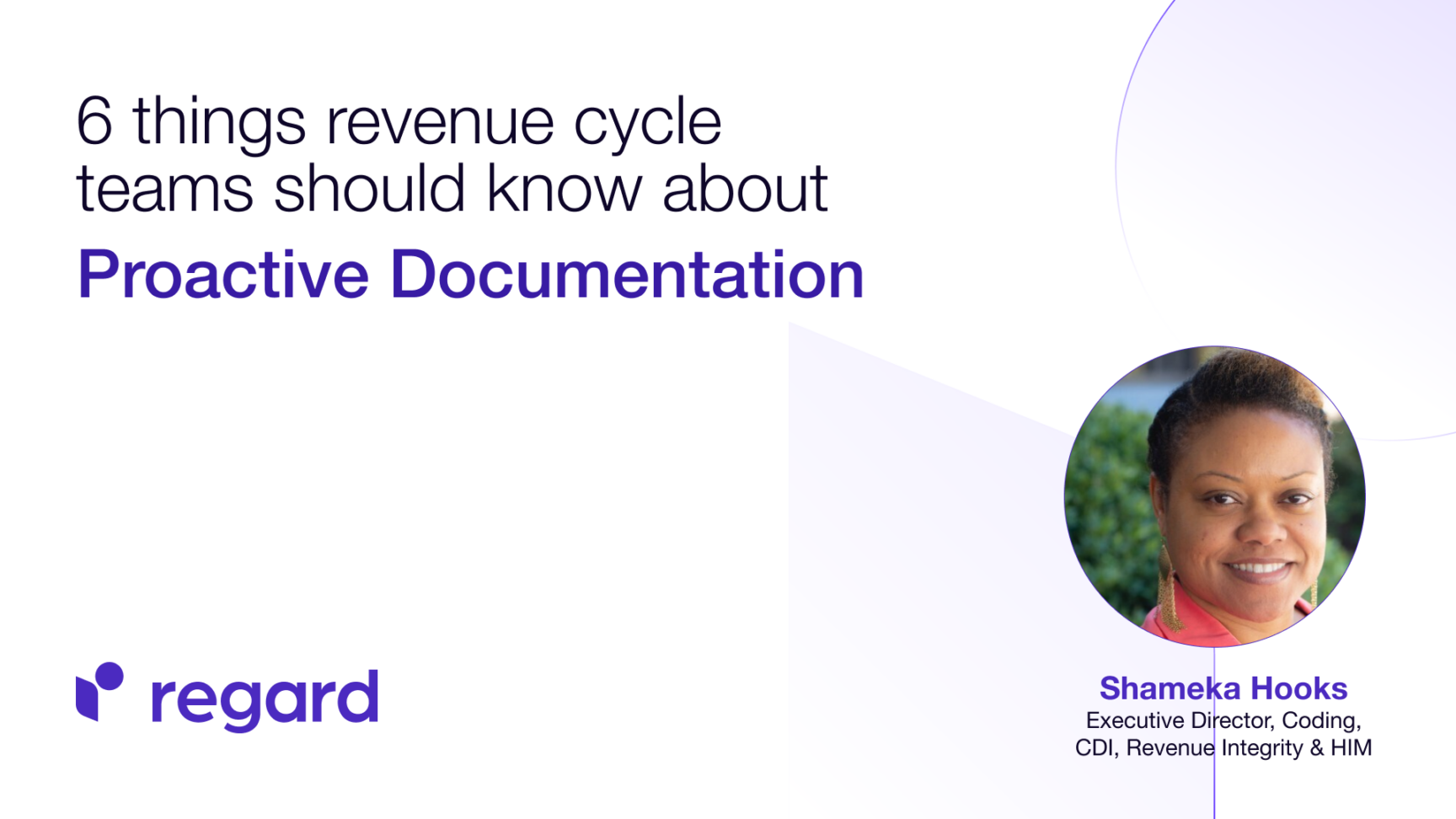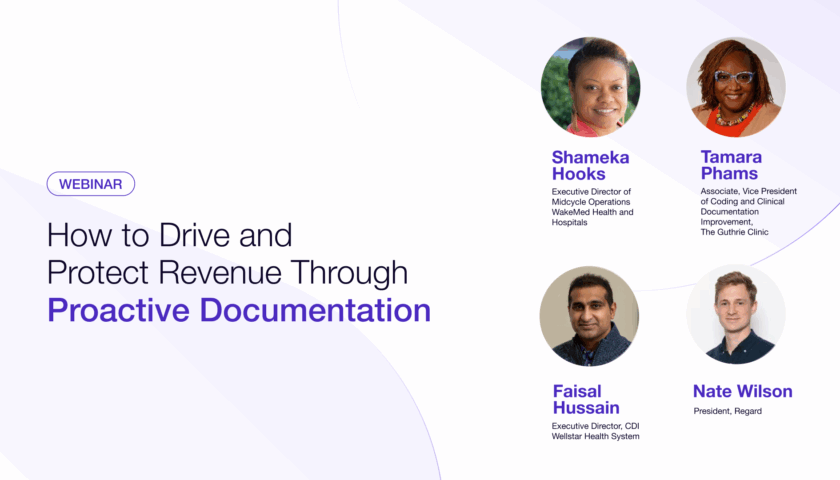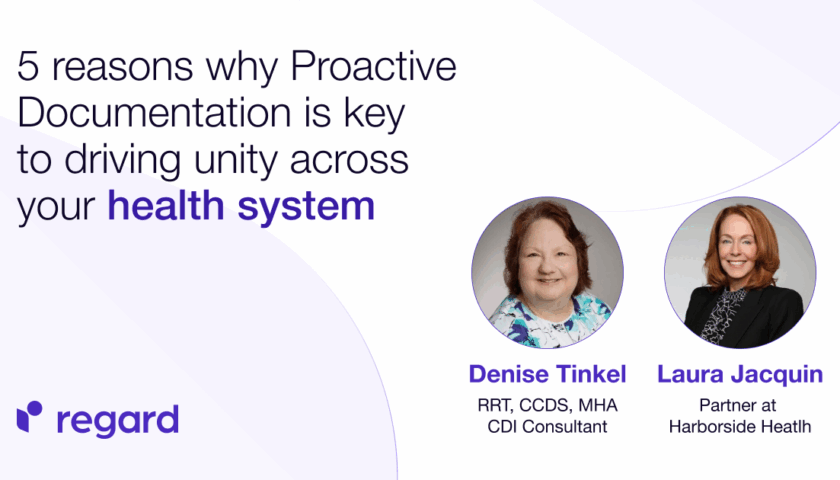
Across the complex healthcare ecosystem, we’ve found that one area is a consistent sticking point for physicians, patients, and administrators alike: documentation. Doing it well can mean the difference between reimbursement and a denied claim, or even between effective medical treatment and misdiagnosis. The documentation bottleneck is in large part attributable to the reactive way it happens (detailed in this recent webinar). Thus, tools and methodologies aimed at shifting the paradigm to Proactive Documentation offer a promising solution for alleviating administrative burden and enhancing patient outcomes.
To get a clearer picture of the value of Proactive Documentation from a revenue cycle and Clinical Documentation Integrity perspective, we sat down with Shameka Hooks, MHA, RHIA, CDIP, CCS, who explained the burden clinical and administrative hospital teams feel around documentation, outlined what to look for in a Proactive Documentation solution, and gave her advice on implementing and measuring the success of Proactive Documentation.
Meet the expert: Shameka Hooks is the Executive Director of Midcycle Operations (Hospital Coding, Clinical Documentation Integrity, Revenue Integrity, and Health Information Management) at WakeMed Health & Hospitals in Raleigh, North Carolina. She has more than 24 years of healthcare revenue cycle experience and currently serves as the president of the North Carolina Health Information Management Association (NCHIMA).
These are the top six things you need to know about Proactive Documentation, with detailed insights from Hooks.
#1 What’s the power of Proactive Documentation methodology?
Proactive Documentation is a forward-thinking approach that anticipates and addresses documentation needs before challenges arise. Rather than reacting to gaps or errors after the fact, this methodology emphasizes real-time collaboration between our clinical teams, physicians, and Clinical Documentation Integrity (CDI) specialists to ensure documentation is accurate, complete, and compliant from the get-go. It streamlines our processes, reduces inefficiencies, and allows us to enhance patient care while supporting our administrative goals.
With a tool like Regard, we can fill the gaps that time-pressed physicians might have left or bring forward important information for them. From a coding aspect, we might have a diagnosis that is unspecified, but Regard fills in the highest specificity possible so we can code that account accurately with the severity of illness, risk of mortality, and the correct DRG (Diagnostic Related Group).
Proactive Documentation can also help with denials. Payors often send denials because of a clinical criteria issue, but Regard allows us to address this before we get to a denial by prompting physicians with questions upfront so that Regard can build the clinical criteria for diagnosis and treatment.
Ultimately, not practicing Proactive Documentation puts a burden on your back-end staff, trying to fight those denials. It creates a lot of work for CDI teams going back to the physician with queries to clarify their documentation. A proactive approach will also decrease the burden on physicians by limiting queries to an as-needed basis for more complex cases.
#2 How does Proactive Documentation impact the relationship between CDI teams and clinical staff?
It fosters a collaborative environment where our CDI team and clinical staff work closely to achieve our shared goals. By engaging our clinical teams earlier in the documentation process, our CDI specialists build stronger relationships, we improve communication, and we promote a culture of mutual understanding and respect.
This fosters trust and helps clinicians feel supported rather than burdened. Bringing in tools like Regard signals to our physicians that we’re building systems to help them, not burden them.
The collaboration extends beyond the CDI team and physician groups to our quality team and nurses. For the sake of the patient, healthcare providers, and the business, CDI, coding, and nursing all must work together to ensure that the right documentation is in the chart, including clinical support. This ensures claims go through and patients get what they need.
#3 How can workload and efficiency transform with Proactive Documentation?
Reactive documentation often results in overwhelming workloads for CDI teams, as they must constantly address errors and fill gaps after the fact. This inefficiency can lead to frustration, reduce productivity, and cause delays in claims processing. Transitioning to proactive methodology alleviates these challenges by shifting the focus to real-time collaboration and accuracy, instead of having all documentation fall on the team on the back end.
CDI teams should view this transformation as a strategic opportunity to improve workflow efficiency, enhance their job satisfaction, and contribute to better patient outcomes. For CDI teams, this enhances job satisfaction because they feel that what they’re doing is contributing to patient outcomes rather than feeling overwhelmed with the volume of back-end work. Instead, they can concentrate on more strategic and challenging priorities.
Our small CDI team experienced frustration before we started using Regard because so much communication fell on our team, it’s impossible to touch every single encounter; so some accounts might go out the door without the level of documentation needed to show the complexity of an account. This overwhelms the team, and then physicians are overwhelmed by the queries sent for clarity on the accounts we do have the capacity to touch. This is why having a real-time tool is crucial–so we’re getting the specificity we need during the encounter instead of chasing it down days or weeks later.
One of our physicians mentioned to me that he had a patient that was in-house for 30-days , and as he was documenting progress notes, Regard popped up to surface information from the 13th day and allowed that physician to bring a diagnosis forward that otherwise would have been missed. The benefits are three-fold: patients, physicians, and CDI teams have better outcomes.
To fully realize these efficiency gains, it’s essential to have the right technology partner-one that not only supports real-time documentation but also integrates seamlessly into existing workflows.
#4 What should CDI teams look for in a technology partner when implementing a Proactive Documentation approach?
A technology partner should offer robust solutions that enable real-time documentation and have a seamless integration with our existing systems with advanced analytics to identify trends and gaps.
Features like intuitive interfaces, customizable templates, and automated compliance checks are crucial for us. I’d also recommend a partner that provides strong training support and has experience working with health systems to optimize the adoption process.
We’ve found all these things with Regard. They have been a great partner in integrating with our existing systems, working with our IT team if they have any issues, and coming onsite to work with our physician partners and CDI leadership.
They sit at the table with us to address any challenges, trends, and diagnosis gaps. We go over analytics together and review what we see in our diagnoses, clinical criteria, and denials. Regard will use that information to go back to their system and customize it for our needs in order to optimize outcomes.
#5 What key performance indicators (KPIs) should CDI teams track to measure the ROI of Proactive Documentation?
CDI teams should monitor metrics such as the reduction in claim denials, improvements in coding accuracy, increased reimbursement rates, and decreases in documentation related queries.
Other relevant KPIs include the time spent on documentation corrections, as well as the level of clinical engagement and proactive processes. Tracking these metrics will provide a clear picture of the financial and operational impact of proactive documentation.
#6 What are some best practices for introducing CDI teams and clinical staff to Proactive Documentation?
Start by engaging leadership to champion the initiative and create a buy-in among teams. Provide comprehensive training to CDI specialists and clinical staff, emphasizing the benefits of proactive documentation for patient care and administrative efficiency. Encourage collaboration by hosting regular workshops or discussions that foster open communication between CDI and clinical teams. Finally, leverage technology to simplify workflows, and provide ongoing support to ensure successful implementation.
Our education team is really involved in this process. They host workshops and discussions between the CDI team and clinicians whenever we find trends. We invite clinicians to hear the education and ask questions; and that has helped them understand why our queries are important, and ultimately, why their documentation is so important.
Conclusion
Proactive Documentation isn’t just a process improvement-it’s a strategic shift that empowers clinical and CDI teams to work smarter, not harder. By addressing documentation needs in real time, we reduce administrative burden, improve coding accuracy, and ultimately enhance patient care. With the right tools, strong collaboration, and a commitment to continuous improvement, organizations can transform documentation from a pain point into a powerful asset. Now is the time to move from reactive to proactive-and realize the full potential of documentation done right.


